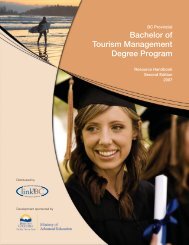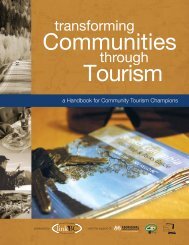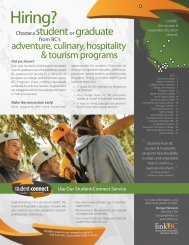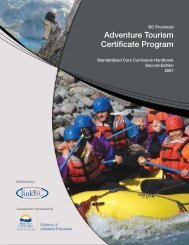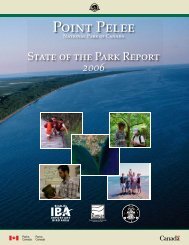Cultural Heritage Tourism Handbook - LinkBC
Cultural Heritage Tourism Handbook - LinkBC
Cultural Heritage Tourism Handbook - LinkBC
- No tags were found...
Create successful ePaper yourself
Turn your PDF publications into a flip-book with our unique Google optimized e-Paper software.
10.4 Measure Your Progress 50Using Evaluation to Improve the <strong>Cultural</strong>/<strong>Heritage</strong> <strong>Tourism</strong> ExperienceRegular monitoring and evaluation of your community-based cultural/heritage tourism strategy isessential. This will measure the level of visitor satisfaction with your community, and help determinewhat may need to be adjusted.Taking these steps will:• Verify the extent to which cultural/heritage programs in your • Product Sales. Every cultural or heritage tourism businessstrategy are meeting their intended goals or objectives.with a retail component should be recording sales on a daily,• Identify the profile and origin of visitors coming to the destination weekly and monthly basis.and detect changes in the profiles of those coming.• Visitor Survey/Questionnaire. Compile a survey or questionnairethat does not overwhelm the visitor (i.e. 5-10 min. max.)• Assess levels of visitor satisfaction with the community, and ofindividual attractions and experiences.Questions should measure different aspects of the visitor’s• Improve marketing methods to reduce cost and increaseexperience and the overall cultural/heritage tourism strategy.efficiencies.Surveys can be administered on site, or using a free online• Examine visitor behaviour once at the destination.survey program.• Determine trends in visitor revenues and economic impact inthe community.• Conversations with Visitors. Have all staff regularly ask visitorsabout their experience. Find out what they liked and didn’t• Assess the quality of facilities, services, and levels of visitor service.like, how they heard about you, and what services or products• Test responses to new or proposed programs, services, or promotionalmaterials.they would like to see. Most of the time visitors are pleased totalk about their experiences!The next step in the process is to analyze the findings and feed them back into decision-makingfor future adjustments. Your task force can begin by asking questions such as:• Does the information collected show we’ve reached our goals?• Does the data highlight any specific initiatives that are workingwell?• Does the information identify any problems that need to betackled?• Are we attracting the kinds of visitors we targeted? Are thereseasonal differences?• Does the information indicate all partners agree on goals andprogramming objectives?• Have we been able to handle any traffic increases to the community?What are the implications for staffing and visitor services?• Does the evidence show we’re providing authentic experiences?• What new opportunities have been identified, and how can weaddress these?Gathering data on a regular basis is just the first step. The importantfactor is how this information is incorporated in ongoing communitybasedcultural/heritage tourism planning! Depending on availableresources, consider whether expertise or additional help should bebrought in (e.g. a professional research team, or a group of college/university tourism students).This next case study demonstrates how a cultural/heritage tourismoperation might use research and monitoring to turn detractorsinto supporters. You’ll note that this festival has kept close recordsof attendance, employment stats, and visitor spend, all importantfactors in making a case for continued operations.Choosing Evaluation ToolsOnce you decide what you are trying to measure as a part of yourevaluation process, you can determine the best tools to use. Ideally,two or three methods should be used in order to get a completepicture of overall performance. Here are some suggested approaches:• Visitor Guestbook or Comment Cards. Provide visitors anopportunity to comment on their experiences at your facility.Reviewing guest comments is the simplest way to check thepulse of your visitor’s experience and allows you to addressissues or concerns promptly.• Web Analytics and Social Media. Applications such asGoogle Alerts will notify you of blog and twitter mentions,news articles, and web mentions relating to your business andyour competitors.• Addictomatic (www.addictomatic.com). This searches theweb for the latest in related news, blog posts, videos andimages—and lets you know what people are saying aboutyour business, attraction or special event.• Monitor web statistics. Do this for all websites that promoteyour cultural/heritage tourism strategy.• Admission Statistics. Encourage admissions staff to keep • Travel Blogs. Consider using Trip Advisor (www.tripadvisor.statistics about ages, numbers in the group, and anything else com) and other similar sites as part of your regular evaluationyou want to track. Ask guests where they are visiting from or program. Beyond data analysis, this is another useful way ofwhat they plan to do. Keep a record so attendance numbers communicating with your customers. Answer any feedbackand demographics can be tracked on a daily, weekly and/or directly, and if users have been less than satisfied, offer to fixmonthly basis.the problem in plain view of your other users.80 81



